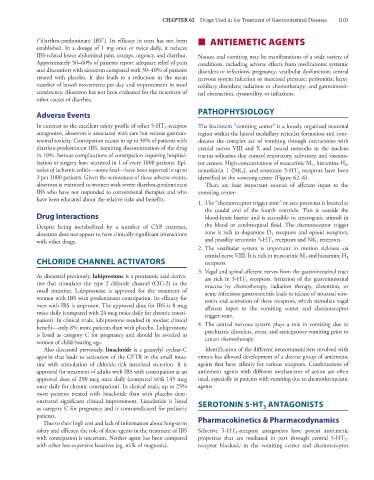Page 1117 - Basic _ Clinical Pharmacology ( PDFDrive )
P. 1117
CHAPTER 62 Drugs Used in the Treatment of Gastrointestinal Diseases 1103
(“diarrhea-predominant IBS”). Its efficacy in men has not been ■ ANTIEMETIC AGENTS
established. In a dosage of 1 mg once or twice daily, it reduces
IBS-related lower abdominal pain, cramps, urgency, and diarrhea. Nausea and vomiting may be manifestations of a wide variety of
Approximately 50–60% of patients report adequate relief of pain conditions, including adverse effects from medications; systemic
and discomfort with alosetron compared with 30–40% of patients disorders or infections; pregnancy; vestibular dysfunction; central
treated with placebo. It also leads to a reduction in the mean nervous system infection or increased pressure; peritonitis; hepa-
number of bowel movements per day and improvement in stool tobiliary disorders; radiation or chemotherapy; and gastrointesti-
consistency. Alosetron has not been evaluated for the treatment of nal obstruction, dysmotility, or infections.
other causes of diarrhea.
Adverse Events PATHOPHYSIOLOGY
In contrast to the excellent safety profile of other 5-HT -receptor The brainstem “vomiting center” is a loosely organized neuronal
3
antagonists, alosetron is associated with rare but serious gastroin- region within the lateral medullary reticular formation and coor-
testinal toxicity. Constipation occurs in up to 30% of patients with dinates the complex act of vomiting through interactions with
diarrhea-predominant IBS, requiring discontinuation of the drug cranial nerves VIII and X and neural networks in the nucleus
in 10%. Serious complications of constipation requiring hospital- tractus solitarius that control respiratory, salivatory, and vasomo-
ization or surgery have occurred in 1 of every 1000 patients. Epi- tor centers. High concentrations of muscarinic M , histamine H ,
1
1
sodes of ischemic colitis—some fatal—have been reported in up to neurokinin 1 (NK ), and serotonin 5-HT receptors have been
1
3
3 per 1000 patients. Given the seriousness of these adverse events, identified in the vomiting center (Figure 62–6).
alosetron is restricted to women with severe diarrhea-predominant There are four important sources of afferent input to the
IBS who have not responded to conventional therapies and who vomiting center:
have been educated about the relative risks and benefits.
1. The “chemoreceptor trigger zone” or area postrema is located at
the caudal end of the fourth ventricle. This is outside the
Drug Interactions blood-brain barrier and is accessible to emetogenic stimuli in
Despite being metabolized by a number of CYP enzymes, the blood or cerebrospinal fluid. The chemoreceptor trigger
alosetron does not appear to have clinically significant interactions zone is rich in dopamine D receptors and opioid receptors,
2
with other drugs. and possibly serotonin 5-HT receptors and NK receptors.
1
3
2. The vestibular system is important in motion sickness via
cranial nerve VIII. It is rich in muscarinic M and histamine H
1
1
CHLORIDE CHANNEL ACTIVATORS receptors.
3. Vagal and spinal afferent nerves from the gastrointestinal tract
As discussed previously, lubiprostone is a prostanoic acid deriva- are rich in 5-HT receptors. Irritation of the gastrointestinal
3
tive that stimulates the type 2 chloride channel (ClC-2) in the mucosa by chemotherapy, radiation therapy, distention, or
small intestine. Lubiprostone is approved for the treatment of acute infectious gastroenteritis leads to release of mucosal sero-
women with IBS with predominant constipation. Its efficacy for tonin and activation of these receptors, which stimulate vagal
men with IBS is unproven. The approved dose for IBS is 8 mcg afferent input to the vomiting center and chemoreceptor
twice daily (compared with 24 mcg twice daily for chronic consti- trigger zone.
pation). In clinical trials, lubiprostone resulted in modest clinical
benefit—only 8% more patients than with placebo. Lubiprostone 4. The central nervous system plays a role in vomiting due to
is listed as category C for pregnancy and should be avoided in psychiatric disorders, stress, and anticipatory vomiting prior to
women of child-bearing age. cancer chemotherapy.
Also discussed previously, linaclotide is a guanylyl cyclase-C Identification of the different neurotransmitters involved with
agonist that leads to activation of the CFTR in the small intes- emesis has allowed development of a diverse group of antiemetic
tine with stimulation of chloride-rich intestinal secretion. It is agents that have affinity for various receptors. Combinations of
approved for treatment of adults with IBS with constipation at an antiemetic agents with different mechanisms of action are often
approved dose of 290 mcg once daily (compared with 145 mcg used, especially in patients with vomiting due to chemotherapeutic
once daily for chronic constipation). In clinical trials, up to 25% agents.
more patients treated with linaclotide than with placebo dem-
onstrated significant clinical improvement. Linaclotide is listed SEROTONIN 5-HT ANTAGONISTS
as category C for pregnancy and is contraindicated for pediatric 3
patients.
Due to their high cost and lack of information about long-term Pharmacokinetics & Pharmacodynamics
safety and efficacy, the role of these agents in the treatment of IBS Selective 5-HT -receptor antagonists have potent antiemetic
3
with constipation is uncertain. Neither agent has been compared properties that are mediated in part through central 5-HT -
3
with other less expensive laxatives (eg, milk of magnesia). receptor blockade in the vomiting center and chemoreceptor

